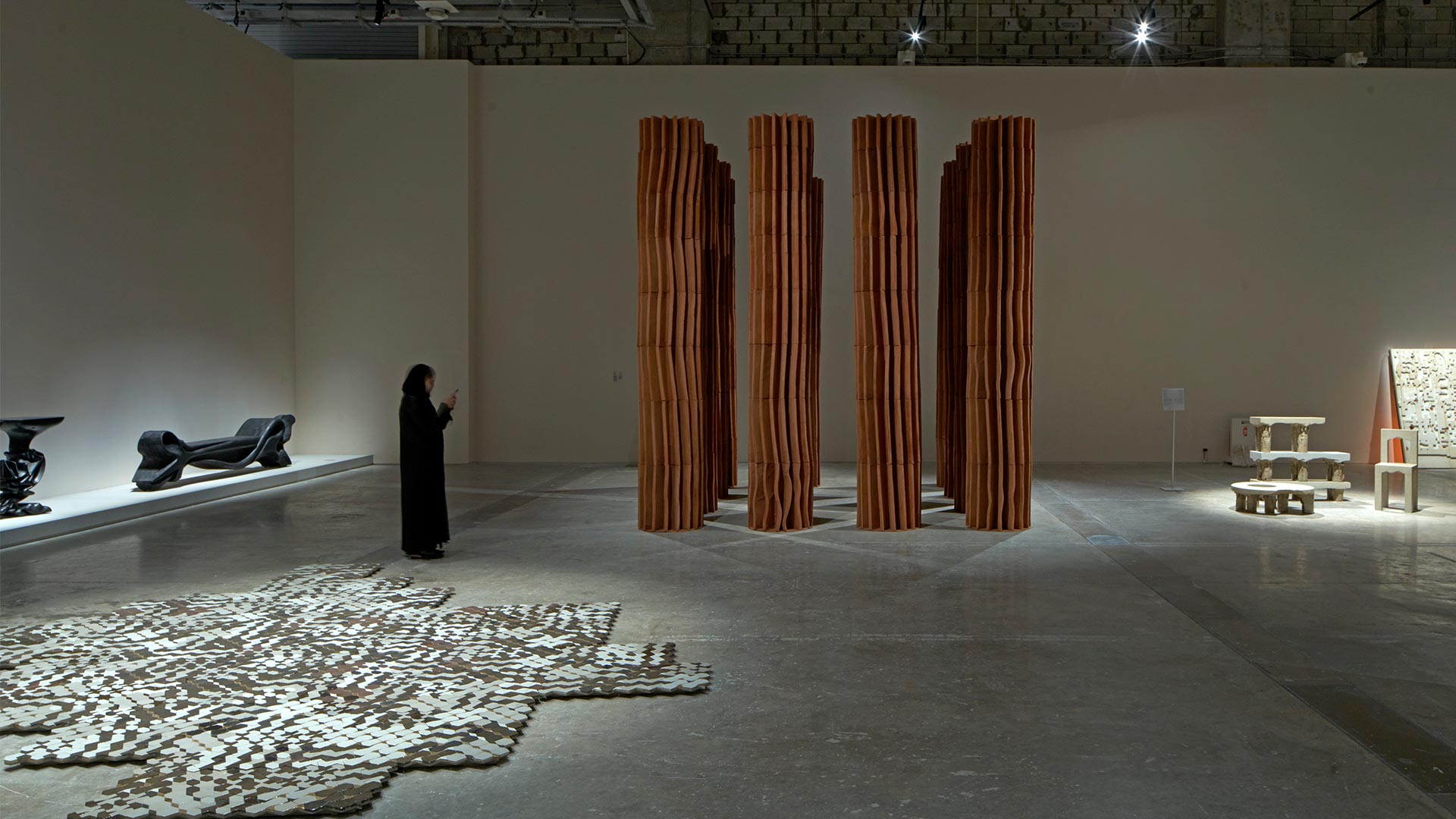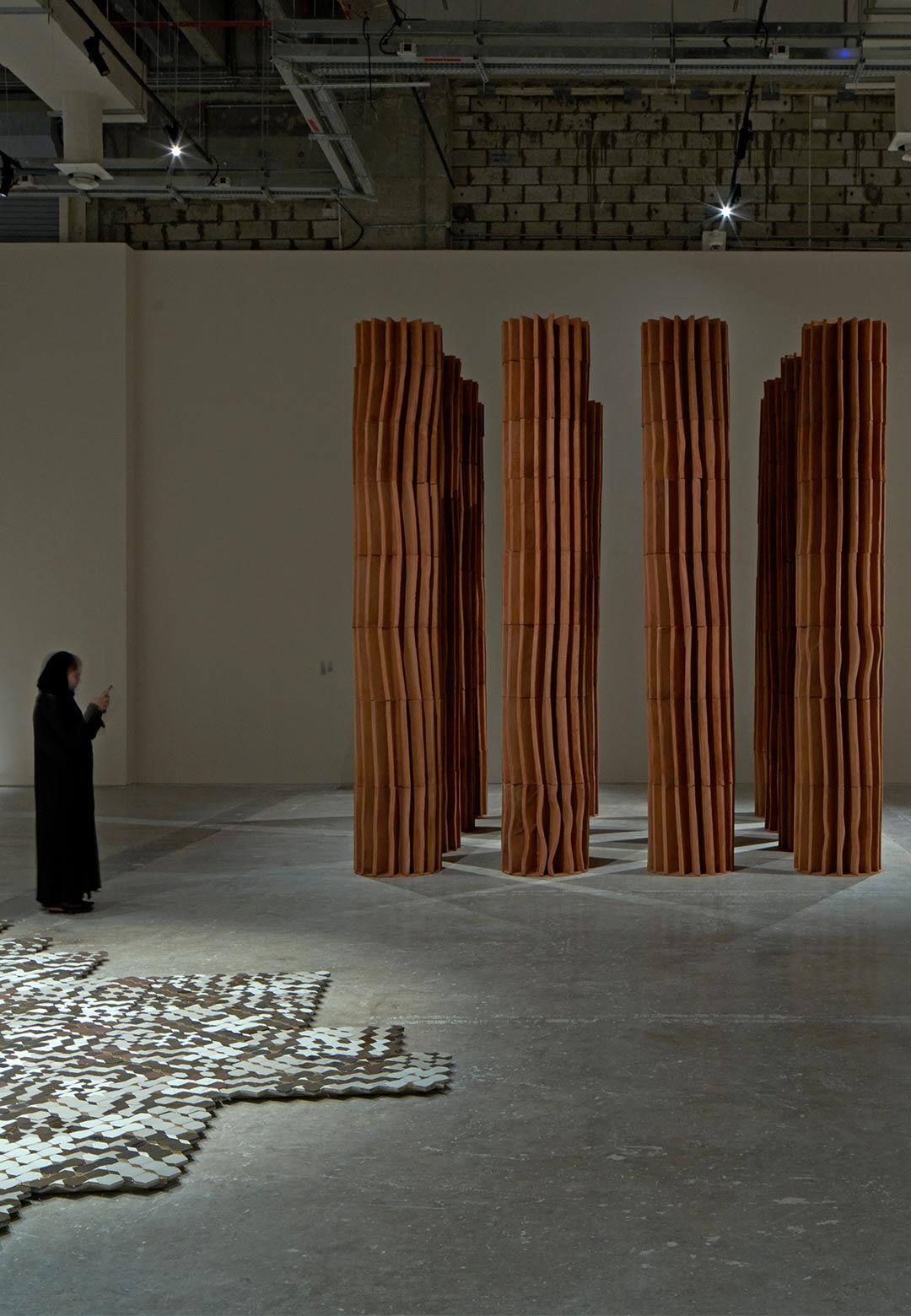On February 24, 2024, the inaugural edition of Design Doha, a design biennial dedicated to the showcase of design innovation in the MENA region, opened in Doha, Qatar. Heralded by Qatar Museums, the design event, open until August 5, 2024, is host to a series of exhibitions, discourses and engaging events that focus on the design scene in the MENA region as well as its role in global trends.
Of the many showcases at the design festival, the headline exhibition, Arab Design Now, presents a varied curation of 38 works by more than 70 Arab designers. On view at M7, an art centre in Doha that also encompasses innovation in the realms of fashion and design, the exhibition examines several themes that are developed in response to the unique geography and culture in the region. The rich showcase is curated by Rana Beiruti, curator and co-founder of Amman Design Week. The exhibition does a fine job of balancing contemporary design and art against traditional methods derived from the region’s heritage. Various works also particularly focus on addressing environmental concerns, with sustainable design. From Palestine, Egypt, Jordan, Lebanon, Iraq, Syria, Qatar, United Arab Emirates, Saudi Arabia, Bahrain and Kuwait to Morocco, Algeria and Italy, the exhibitors hail from the region and beyond.
Showcases from Qatar include Basma Hamdy’s screen-printed artworks, Maryam Yousuf Al-Homaid’s textile works, and Abdulrahman Al Muftah’s traditionally crafted rugs, amongst others. Bahrain’s retinue, on the other hand, comprises Ali Ismail Karimi’s speculative project House between a Jujube Tree & a Palm Tree Diptych; Anne Holtrop’s large-scale installation made out of resin, Noor Alwan’s Sacred Spaces, as well as works by Maitham Almubarak, Batool Alshaikh, Christian Vennerstrom Jensen and Hala Kaiksow.
Some exhibitors from Palestine include Maïa Beyrouti, Yousef and Elias Anastas, Samer Selbak, Lameice Abu Aker and Dima Srouji. While Franco-Palestinian artist Beyrouti showcases three new side tables at the fair, Yousef and Elias Anastas’s Tiamat is an architectural experiment that explores the possibilities of stone construction in contemporary times. Selbak’s Luffa Project features a room divider and a pendant lamp made using loofah fibres dyed with natural pigments, Aker’s glassware objects are hand-blown in Palestine, and Srouji’s Maintaining the Sacred II: Transparent Histories is an installation that imagines the future archaeology of a liberated Jerusalem.
The heavy entourage of Lebanese designers at the exhibition include the likes of David Raffoul and Nicolas Moussallem, Georges Mohasseb, Haria Hibri, Huda Baroudi, Tessa and Tara Sakhi, Christian Zahr, Tamara Barrage, Najla El Zein, Carla Baz, Mary-Lynn and Carlo Massoud, Charles Cremona, Flavie Audi, Joe and Amanda Bou Abboud, Nada Debs, Nada Rizk, Thomas Trad, Adrian Pepe, Anastasia Nysten, Karen Chekerdjian, Richard Yasmine, Aline Asmar d’Amman and Smar Saadeh. These showcases encompass artistic sculptures, vessels, textile works, furniture and lights made out of different natural and man-made materials, and sculptural and material experiments condensed into design installations.
Showcases from Jordan include the Constellations chandelier by Abeer Seikaly, a terracotta column installation by Sahel Alhiyari, Hussein Alazaat’s Memories of the Coming Day, Ishraq Zraikat‘s Raw Embrace rug, Hiba Shahzada’s architectural installation Reverie, and Dina Haddadin’s nomad pavilion Sabil. Some Egyptian designers and design practices at the show include 40MUSTAQEL, Omar El Wakil, Sherine Salla, Lina Alorabi and Nora Aly; and Algerian designers comprise Azel Ait-Mokhtar, Youri Asantcheeff, Meriem Chebani and John Edom.
Iraqi designer Hozan Zangana’s The Promised Land is a collection of sculptures that bridges the gap between the ancient and modern, and Iraqi-Dutch visual designer Nedim Kufi’s artworks at the exhibition are an abstraction of his thoughts. Sizar and Sinar Alexis, a brother-sister duo, present Lamhu & Ousia, a furniture collection, at the design fair. Louis Barthelemy, a multidisciplinary artist and designer based between Marrakech, Cairo and Paris, presents three tapestries, entitled Manhood, Dancer and Gazelles, at the design exhibition.
Some other designers from the MENA region include Moroccan designers Achraf Mzily, Salima Naji, Hamza Kadiri, Amina Agueznay and Amine Asselman; Syrian creatives Ali Kaaf, Talin Hazbar and Nader Gammas; Saudi designers Filwa Nazer, and Turki and Abdulrahman Gazzaz; Kuwaiti designers such as Hamed Bukhamseen, Maysaa Almumin, Mohammad Sharaf, Thomas Modeen, Kawther Alsaffar and Jassim Al Nashmi; and those from the UAE, namely Omar Al Burg, Irthi Council, Riem Ibrahim, Hala Al-Ani and Hadeyeh Badri. Accompanying the entourage of designers from the Global South are Italian designers Edoardo Pandolfo and Francesco Palu. The exhibition is also accompanied by a publication that surveys the works of designers displayed at the exhibition.
In order to understand the curatorial process and the significance of a design event of this nature in the region, STIR established a dialogue with Rana Beiruti, who is based in Amman, Jordan, and is the principal curator for the exhibition Arab Design Now. The following are edited excerpts from the interaction.
Almas Sadique: How do Arab designers address the question of sustainability? What are some differences from the canonical procedures followed in the West?
Rana Beiruti: There is a strong cultural attachment to the land in the Arab world. The crafts of the region were born from the unique geographies that produced unique materials such as palm, dates, and a multitude of earth materials and clays which could be harvested to produce objects of significance. Designers not only extracted inspiration and a deep understanding of identity from the land, but they were also able to harvest materials and innovate with them. For many, this entails a lot of innovative research with these unique materials that are unavailable in the West. Examples include the work of Sama Elsaket which proposes to research a palette of all of the potential clays that can be found in Jordan, or the work of Bone Studio which proposes a home partition making use of a newly innovated material created out of date seed. There is introspection and digging deeper into local resources that lends itself to the conversation on sustainability and the importance of local production that is not extractive, but friendly to the environment. Designers also are able to merge between tradition and indigenous knowledge and practice which has developed to work collaboratively with nature, with more contemporary methods of making.
Almas: Tell us about the curatorial process of Arab Design Now.
Rana: When I was asked to create a survey exhibition titled Arab Design Now about design in the region, I began by having conversations with the designers across the Arab World -- from the Levant to the Gulf, to North Africa. The exhibition was built on these dialogues which aimed to showcase both the diversity of the region, which encompasses various landscapes, geographies, cultures, and aesthetics, but also to begin to map commonalities in approach, process, and values. These commonalities became the threads, or themes, that tied the exhibition together.
Almas: How was the title for the exhibition finalised?
Rana: The title of the exhibition was selected by the Design Doha team as it is intended to become a recurring exhibition with the same name. The term 'Now' is meant to denote that this exhibition is showcasing the latest in contemporary design from the Arab world, as opposed to being an exhibition of historic works.
Almas: What are some interesting responses that you have received so far, for your exhibition?
Rana: The word I heard the most in reference to the exhibition is "powerful". I found it interesting that the word power is used, but I think it is testimony to how the population of the Arab world believes there is power in unity and in coming together.
Almas: What are the different kinds of works displayed at the exhibition? What kinds of themes do they address?
Rana: The exhibition encompasses craft, furniture design, graphic design, objects, as well as architectural pavilions and installations. The works address common preoccupations that are top of mind in the Arab world. To name a few: they address notions of identity as it is tied to the land and material, as well as sustainability and ways of making and building. The architectural pavilions and high-quality crafted furniture design showcase the use of modern technologies and advanced methods of making, and how they can be merged with the traditional. There are showcases that reference the rapid urban development, particularly in the Gulf countries of the Arab world. The exhibition ends with a focus on the Arabic language, undeniably one of the most important threads that ties us together, and one that has a script that has been primary in the aesthetics of the Arab world.
‘Arab Design Now’ is on view from February 24 to August 5, 2024, at Design Doha, in M7, Msheireb, in Doha, Qatar.
- Contemporary Design
- Curator
- Design Event
- Design Exhibition
- Design Fair
- Design Festival
- Design Installation
- Egypt
- Furniture Design
- Furniture Designer
- Italian Designer
- Italy
- Large Scale Installation
- Lebanese Designer
- Lebanon
- Middle East
- Nada Debs
- Product Design
- Product Designer
- Resin
- Richard Yasmine
- Saudi Arabia
- Side Table
- Sustainability
- Sustainable Design






 Sign in with email
Sign in with email










What do you think?